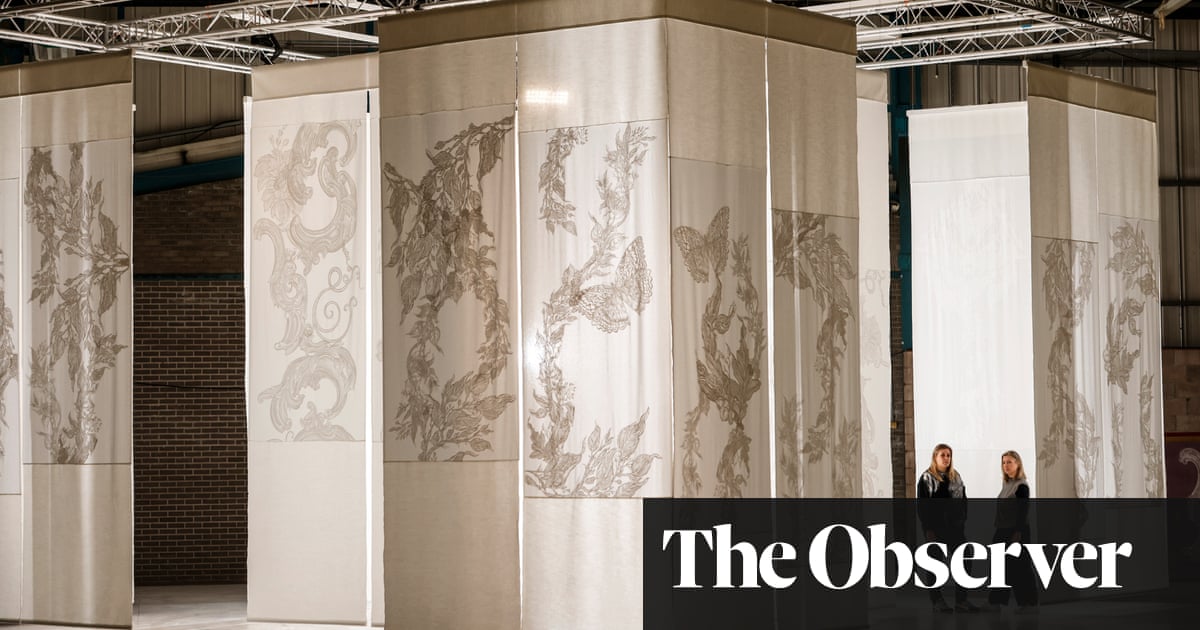The city of Dundee, about 60 miles north of Edinburgh on Scotlandâs east coast, was once best known for its industry: whaling and shipbuilding in the 19th century, then its celebrated âthree Jsâ â jute, jam and journalism. But in recent years, Dundee has developed another reputation: as an arts and culture hub, and the UKâs first and only Unesco-designated âdesign cityâ.
On Friday, at a former Michelin factory in the north-east of the city, the finishing touches were being put in place for the fifth Dundee design festival, which opens on Monday. The Âfestival, held every two years, showcases work by more than 180 designers across disciplines including textiles, homeware and more.
In the factory, a colourful woodland of knitted trees points towards a collection of bookends commissioned from Scottish designers and inspired by the globetrotting travels in 1894 of Dundee Courier journalists Marie Imandt and Bessie Maxwell. Elsewhere, sculpture made from coat hangers sits alongside jewellery, ceramics and furniture.
âWeâre obsessed with design and we just want other people to see why weâre so passionate about it,â said the festivalâs creative director, Stacey Hunter. âYou can tell so much about a society by the way it designs things and expresses itself. Itâs what gives objects meaning.â
Exhibits ranging from tables, chairs and vases to video games, costumes and aeroplane seats are displayed on reworked plinths and backdrops salvaged from previous exhibitions and retail deadstock â a mark of the festivalâs zero-waste commitments. Visitors will be able to attend free practical drop-ins on disciplines ranging from screenprinting to biophilic design, alongside a programme of talks and discussions.
This yearâs festival will mark 10 years since Unesco designated Dundee a design city, alongside Berlin, Montreal, Istanbul and others. The accolade is given to cities that have an established design Âindustry and opportunities for designers, among other criteria. âThe designation recognises everything that was happening here already and it also gives us access to so much,â said Annie Marrs, lead officer for Unesco City of Design Dundee. âFor us, itâs about getting design and creativity out into communities across the city. With the festival, we want to build capacity, grow skills, employ people and create opportunities to make a living from being a designer here.â
In 2018, the Victoria and Albert Museum opened V&A Dundee on the cityâs waterfront, the star attraction in a £1bn regeneration of what was once dockland. The V&A, Scotlandâs first design museum, is housed in a striking geometric building designed by Japanese architects Kengo Kuma and Associates, and inspired by the jagged cliffs of north-east Scotland. The city is also home to Duncan of JordanÂstone College of Art and Design (DJCAD), one of the UKâs top art schools.
âI donât think thereâs another place in the UK that could have this building,â said the museumâs director, Leonie Bell. âWith all our history and now the art school, the Unesco dÂesignation and the incredibly epic and exciting journey the design Âfestival is on, youâve got a real Âlayering of design heritage in Dundee, but also the potential to use it and keep the future journey going.â
The welcome desk for the festival stands upon a set of paving slabs â known by the Scots word âcassiesâ, which are cut with patterns to Âemulate woven designs associated with Dundeeâs textile history.
The cassies were co-created with Dundee residents after hundreds of hours of consultation about how they wanted the city centreâs redesigned Union Street to look.
âSince the designation, weâve been working more collectively with groups throughout the city, showcasing how design can make a positive impact to their daily lives,â said Gary Kennedy, a co-designer of the slabs and co-founder of the architectural practice Kennedy Twaddle.
âWeâre reaching a lot of different people that donât consider themselves designers. Weâre propped up by being a Unesco city of design.
âThat is Âhaving impacts in communities across the city.â
Alongside his practice, Kennedy and the co-designer of the cassies, Linsey McIntosh, teach at DJCAD.
after newsletter promotion
McIntosh said their students Âbenefited from the ambition driven by the Unesco recognition. âTheyâre not designing in a Âbubble within the confines of DJCAD, but Âgetting out there and engaging with people and design across the city,â she said.
âIt gives them another string to their bow and makes them more employable. The opportunities are becoming more and more here â itâs really building momentum, and students want to stay here now rather than disappearing to London.â
Designer and craftsman Camillo Feuchter, whose work features in the festival, graduated in June in interior and environmental design. On Dundeeâs Annfield Road, the results of his ambitious thesis project can be seen in the form of EH9, a Âcoffee shop. He designed and built its interior from scratch â from its service counters and partition walls to the 3D-printed lampshades inspired by the cafeâs rippled mugs, and stools built from recycled plastic.
âThereâs a really supportive Âcreative community â within such a short time I feel so embedded,â said Feuchter.
Many here describe Dundee as a âgoldilocksâ city for creativity: not too big and not too small, but just the right size to cultivate connections and create ambitious work. That is a description Feuchter recognises: âThereâs so much going on, but itâs on a level where you can make a name for yourself.â
That future looks bright for the city, with Scotlandâs first iteration of the Eden project and a cutting edge visual effects lab among new developments set to arrive in the coming years.
Back at the Michelin factory, between sewing costumes and Âadjusting lighting, Marrs said: âThings feel really exciting.
âOur Unesco designation is for life and it belongs to everyone â there are so many possibilities.â

